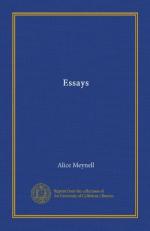And like that order is the order of the figure of man, an order most beautiful and most secure when it is put to the proof. That perpetual proof by perpetual inflection is the very condition of life. Symmetry is a profound, if disregarded because perpetually inflected, condition of human life.
The nimble art of Japan is unessential; it may come and go, may settle or be fanned away. It has life and it is not without law; it has an obvious life, and a less obvious law. But with Greece abides the obvious law and the less obvious life: symmetry as apparent as the symmetry of the form of man, and life occult like his unequal heart. And this seems to be the nobler and the more perdurable relation.
THE PLAID
It is disconcerting to hear of the plaid in India. Our dyes, we know, they use in the silk mills of Bombay, with the deplorable result that their old clothes are dull and unintentionally falsified with infelicitous decay. The Hindus are a washing people; and the sun and water that do but dim, soften, and warm the native vegetable dyes to the last, do but burlesque the aniline. Magenta is bad enough when it is itself; but the worst of magenta is that it spoils but poorly. No bad modern forms and no bad modern colours spoil well. And spoiling is an important process. It is a test—one of the ironical tests that come too late with their proofs. London portico-houses will make some such ruins as do chemical dyes, which undergo no use but derides them, no accidents but caricature them. This is an old enough grievance. But the plaid!
The plaid is the Scotchman’s contribution to the decorative art of the world. Scotland has no other indigenous decoration. In his most admirable lecture on “The Two Paths,” Ruskin acknowledged, with a passing misgiving, that his Highlanders had little art. And the misgiving was but passing, because he considered how fatally wrong was the art of India—“it never represents a natural fact. It forms its compositions out of meaningless fragments of colour and flowings of line . . . It will not draw a man, but an eight-armed monster; it will not draw a flower, but only a spiral or a zig-zag.” Because of this aversion from Nature the Hindu and his art tended to evil, we read. But of the Scot we are told, “You will find upon reflection that all the highest points of the Scottish character are connected with impressions derived straight from the natural scenery of their country.”




